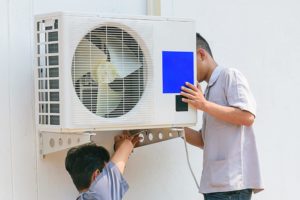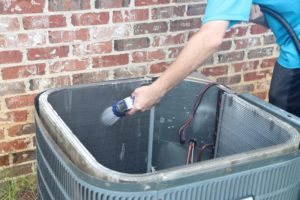Most homeowners spend anywhere from $1,800-$7,100 on HVAC systems, with an average reported cost of $5,238. At the very most, you can expect to pay $10,000. However, there are many factors that aren’t taken into consideration in these national averages. Estimating an exact cost for a HVAC system is difficult. Prices vary based on the type of system you want to install and the size of your home. For example, a 1,000 square foot home, you can expect to pay anywhere from $6,000-$12,000 dollars for the system. Central A/C units can cost about $3,000-$5,000 for a home that is 2,000 square feet. Central heating normally ranges from $2,500-$7,500. If your home requires additional ductwork or ventilation updates, you can expect to pay anywhere from $1,000-$3,000. These are all generalized prices that vary based on the individual and home. So How Much Does A New AC Unit Cost In AZ? Keep reading to learn about the costs of air conditioners and what to expect.

FACTORS IN THE COST OF A NEW A/C UNIT
If your HVAC unit is acting up or keeps breaking down, then it may be time to consider installing a new one. HVAC (Heating, Ventilation, and Air Conditioning) systems are the foundation for controlling the temperature and air quality for both residential and commercial properties. When shopping the market for a new HVAC system, there are a few factors to consider when estimating the total cost. The first cost you should consider is the price of the unit. There are many different types of units, that range in size and efficiency. The more advanced the unit, the more likely you are to pay more. You should consult a professional HVAC technician or contractor about what type of system would best meet the needs of your home and your family. It’s important to work with a professional, who can properly evaluate your home and give you a comprehensive review. Hiring a contractor can help you avoid hidden fees and unexpected updates. For example, the cost may differ for an ac unit for a 1000 sq ft home vs an air conditioner for a 2000 square foot house, plus a contractor may also discover that your duct work needs updating, or your ventilation system isn’t up to date. This can add to your total costs, in addition to the installation fees from the contactor you are working with.
Replacing an existing system
Here your biggest concern is not matching the old unit’s size but getting an accurate measurement of your home’s cooling load.
Installing a system from scratch
Expect to pay more for running new ductwork for both return and supply lines.
Level of quality
A handful of manufacturers make more than 20 labeled brands of central air conditioners, in at least three pricing levels from low end to high end; the level you choose could save or add thousands.
Efficiency
You can save up-front costs by choosing a less efficient system but pay for many years in far higher energy bills than if you had opted for a more efficient (but more expensive) system in the first place.
Depending on your choices and home particulars, you could pay as little as $1,800 or as much as $10,000 for a complete, professional installation of new central air conditioning equipment in your Phoenix home.
Energy Efficiency
Efficiency definitely can bump up the average cost of new ac units. While brand name, reliability and installation are all critical factors in considering a new system, energy efficiency is the step most people gloss over, both on the sales side and the buying side. This is because, frankly, many people do not understand the importance of the numbers.
At ACE Home Service we really want our customers to be happy, not just this month, but every month when they receive their power bills. This is why we stress the importance of a couple of numbers:
SEER
Seasonal Energy Efficiency Ratio is a yardstick for comparing one central air conditioner to another. It is the ratio of the cooling output of an air conditioner over a typical, regional cooling season divided by the energy it consumed in watt-hours. While 15 SEER will be the new minimum for Arizona by 2023, look for the highest number you can afford (up to 25 SEER),to save the most energy over the life of your system
EER
Energy Efficiency Ratio sounds almost the same as SEER, but it is not. It is an instantaneous calculation of the energy used by a cooling system assuming a constant outside temperature of 95 degrees, a constant inside temperature of 80 degrees and a humidity level of 50 percent. Though used mostly for window air conditioners, it is very handy for comparing different brands without regard to geographic or seasonal differences (such as the typical low humidity of our desert landscape).
By paying attention to both these numbers, you can home in on a system that will not only provide cooling and comfort, but will be kind on your budget, too.
Brand Names

No two-part central air conditioner is ever finished in a factory. Unless you opt for a package unit, you will have an outside component (the fan, compressor and condenser) and an inside component (the evaporator and air handler). The last step of assembly for your new central air conditioner is completed by a talented, knowledgeable technician on site.
So while brand names are important, correct installation is actually more important. A good technician can install and balance a mid-range brand and model and have it outperform a high-end model installed incorrectly.
No more than about seven manufacturers produce all 150-some major brands of central air conditioning equipment in the United States today, as the experts at Consumer Search point out.
And even those seven manufacturers depend on a very small handful of parts makers, so most of the central air conditioners sold use all the same parts.
The secret to a great installation is not, then, the actual brand name (though one manufacturer will produce a good-better-best product line), but the installer.
Professional Installation
You will pay additional charges for installation. Depending on your home’s characteristics, new ductwork may be needed, or changes may be necessary based on the new equipment’s footprint. A good installer will do more than remove the old unit and reconnect the new one using the same set-up.
Everything from the programmable thermostat to every register in the house must be accounted for in the new installation. Balancing a system means ensuring adequate airflow (no hot or cold spots), good filtration and no drop in air pressure or volume from cool air on the supply side to stale air on the return side.
Making a Choice
If we had to recommend a strategy for selecting and financing a new or replacement central air conditioner, we would suggest to our friends:
- Get an assessment of your current system’s health and life expectancy.
- Pick a reliable brand and then select the highest EER and SEER product you can afford.
- Communicate with your HVAC contractor to ensure new calculations for cooling load will be made before purchase and installation.
- Purchase a new system sized correctly for your cooling load, no larger.
- Be very particular about installation details and add-ons (deep-media filter, Wi-Fi thermostat, variable-speed air handler and so forth).
- Determine all financing details with the HVAC contractor before signing.
You will be absolutely delighted with your new, more energy-efficient central air conditioner if you strike a balance between logical economics and your family’s desire for comfort through the long Phoenix cooling season. More, you will be delighted with your continued savings by arranging smart financing, buying an energy-efficient system that holds down monthly power bills and carries low maintenance and repair costs.
WHAT MAKES UP AN A/C UNIT?
- Condenser
- Compressor
- Evaporator coil
- Air handler
- Filter
- Ductwork
Add-ons can make your particular system a bit more complex, but each of these parts has its own repair cycle. That is, with an annual or (better) semiannual inspection and service, your HVAC technician can anticipate failures of this pulley or that drive belt, or the time to switch out this part or that. Incorporating these small repairs into the annual visit helps you save money.
With age, the various parts of your central air conditioner begin to fail with greater frequency, so you see your HVAC repair person not only at annual inspections, but for emergency calls, too. These are squeezed into the contractor’s schedules and are more expensive.
Even with increasing spending on repairs, you will still eventually need to replace your system. In the greater Phoenix area, getting 10 years of top-notch performance from an AC unit is typical. Stretching it to 15 years is rare.
Only you can decide how much money you want to pour into an old system. Its efficiency (which translates into your power bill) will not increase with increased tinkering. Your comfort will gradually erode, and you could actually damage your furnishings from an older system’s inability to properly dehumidify the air.
HOW MUCH DOES A NEW AC UNIT COST IN AZ? HERE ARE OTHER OPTIONS.
Central air conditioners use duct systems that work in conjunction with a heating system to
keep your home cool and comfortable. If a central A/C is out of your budget or not right for your
home, then you may want to consider your options:
● Window units: a single A/C system that can be installed directly in your window
● Split systems: either ductless or central systems that can be installed inside and outside of
your home
● Portable units : easily transportable A/C unit that can moved around the house from room
to room
In order to avoid high electric bills and get the most out of your A/C, you should pick one
that fits the size of your home. For small spaces, window units and portable units are your best
bet. If you have a spacious home with lots of room, you will want a central A/C or split system
A/C that can circulate air throughout the entire area. If you aren’t sure which system is right for
you, you can consult a local professional, who can come to your home and give you a
comprehensive recommendation. Different A/C systems have different features and performance
abilities, which can be overwhelming when trying to pick the right unit for your home. Let your
friends at ACE Home Services help with your decision!
Need AC System Sizing And Installation In Phoenix AZ? Call ACE Home Services!!

When you are ready to learn more, remember you have a choice. You could go online and type in a search like “ac replacement cost phoenix,” hoping you land on a helpful (and honest) contractor’s page. Or you can contact the friendly professionals at ACE Home Services. We can outline your options, discuss current specials and help you choose the right central air conditioner for your home. Call (602) 428-3341 to schedule AC service today.
